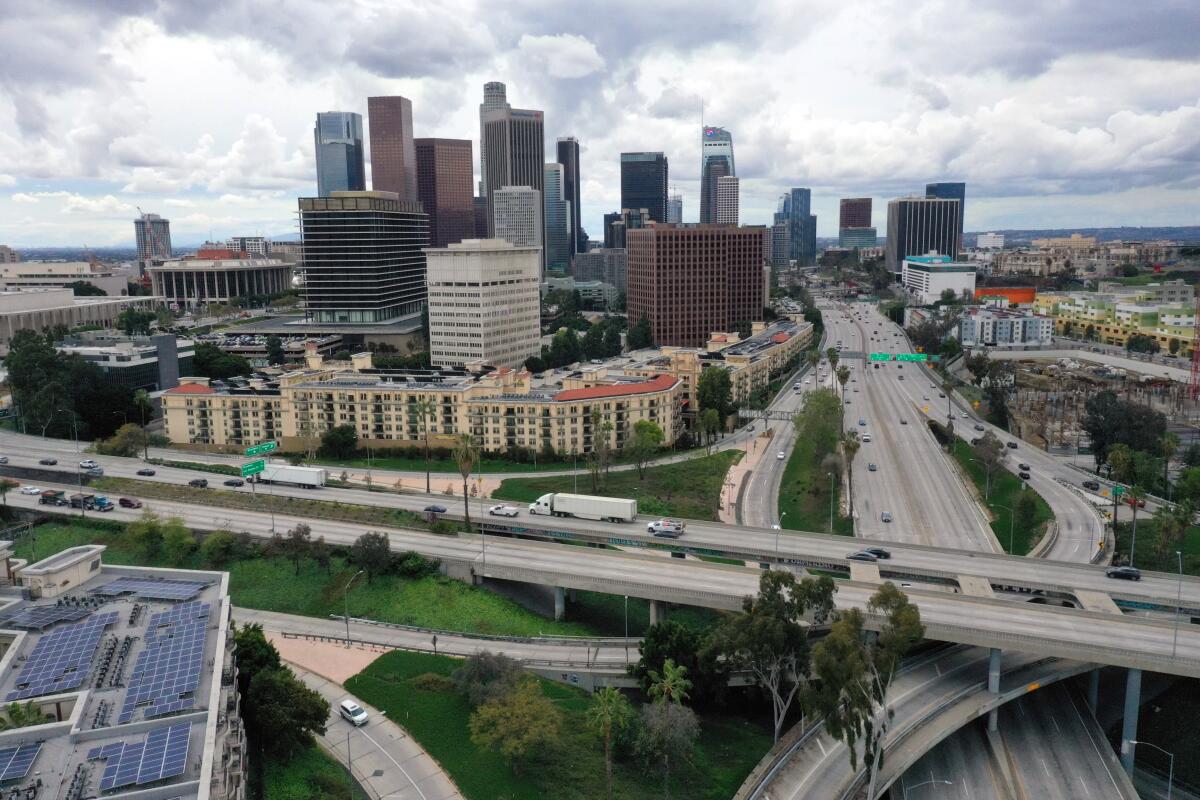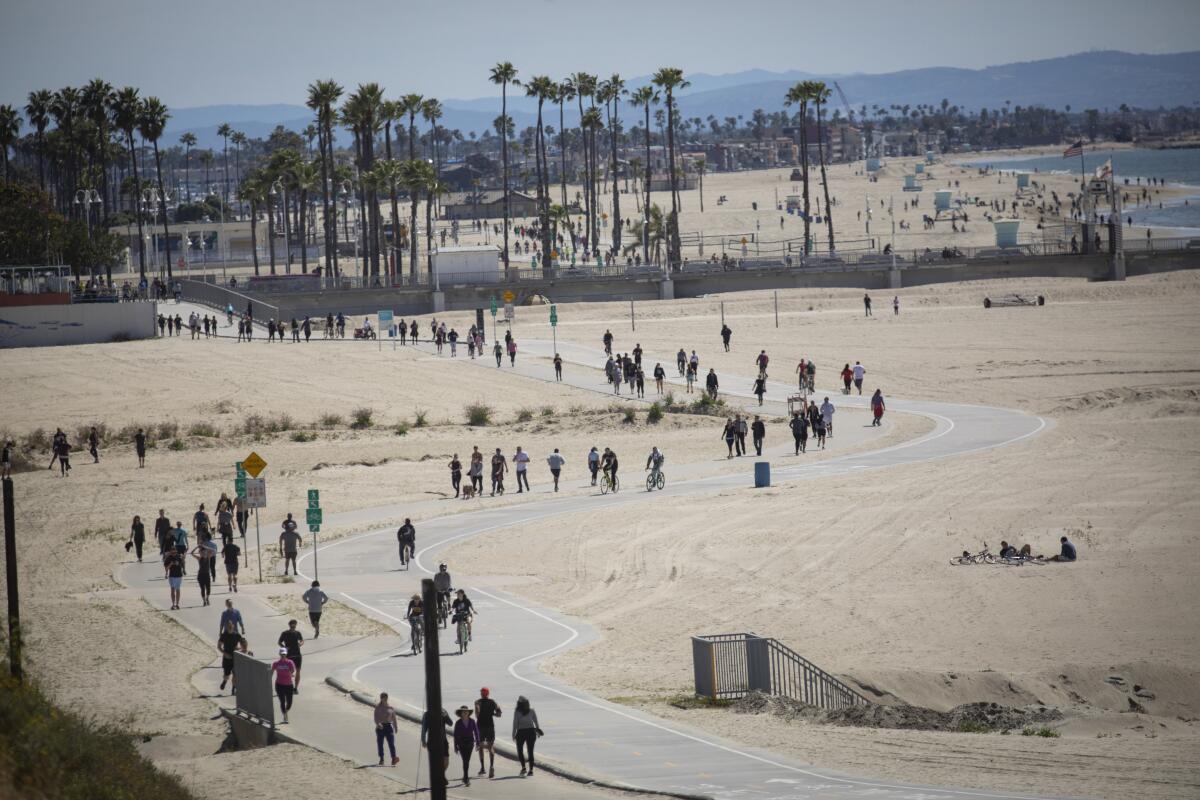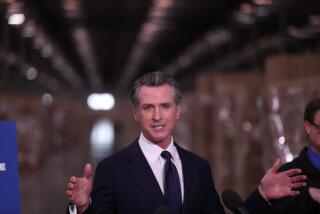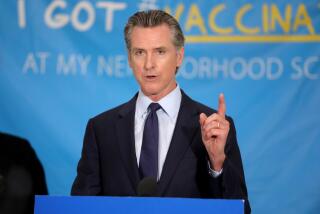‘Time to wake up,’ Newsom says, again urging Californians to stay home in coronavirus fight

- Share via
SACRAMENTO — Gov. Gavin Newsom on Saturday urged Californians to abide by his statewide order to stay at home and, if they choose to venture outside for necessities or recreation, to keep a safe distance from others to prevent the spread of the novel coronavirus.
Newsom also said his administration is working to clear up confusion over whether his historic executive order issued Thursday conflicted with more stringent mandatory restrictions by some California counties and cities. Negotiations with local governments are underway to sort through the “deeply complex” issues involved, he said.
Newsom’s plea for residents to avoid unnecessary social contact comes after scattered reports across the state that some people have been flocking to the coast, gathering with friends or failing to keep proper social distance from others.
The governor stressed that even those who don’t show any symptoms of COVID-19, including young adults who appear to be less likely to become gravely ill if they do contract it, need to cooperate for the good of others in their communities.
“Be a good neighbor. Be a good citizen. Those young people that are still out there on the beaches thinking this is a party time — grow up,” Newsom said during a news conference on Facebook and Twitter on Saturday afternoon. “It’s time to wake up, time to recognize it’s not just about the old folks. It’s about your impact on their lives. Don’t be selfish, recognize you have a responsibility to meet this moment.”

Complaints of noncompliance have popped up on social media and apps such as the neighborhood forum Nextdoor.com. The Marin County Sheriff’s Office on Saturday tweeted out a photo of people congregating on the coast, imploring residents to stay home.
“We understand the communities frustrations with the LARGE amount of people traveling to the Coast today and NOT practicing social distancing. We are working with the Public Health Officers to address the issue. Please stay at home!” the Sheriff’s Office said.
The governor’s stay-at-home order will remain in effect until “further notice” and could be changed as conditions warrant, according to a statement released by the governor’s office. Issued under broad powers granted to the governor under the state’s Emergency Services Act, Newsom’s executive order is enforceable by law.
Anyone who violates the order could be charged with a misdemeanor, but Newsom said he did not believe that would be necessary because social pressures to adhere to the directive have been largely successful.
The Newsom administration Friday night released a 14-page report explaining which businesses and workers are considered essential and exempt from the stay-at-home order, as well as more detail about personal activities that are allowed or prohibited.
The administration of California Gov. Gavin Newsom has released additional details on the executive order to have Californians to stay at home.
Businesses deemed essential and remaining open include gas stations, pharmacies, grocery stores, farmers markets, food banks, convenience stores, takeout and delivery restaurants, banks and laundromats. Those that must close include dine-in-only restaurants, movie theaters and entertainment venues, gyms and fitness studios, and hair and nail salons.
Walking the dog and going on hikes are allowed, but camping at state parks is not. Going to the doctor and pharmacy is allowed, but visiting relatives in the hospital or nursing home is not — with some exceptions, such as when a relative is near death.
Day-care centers and the small number of schools still operating in the state, including those that serve the children of healthcare workers and students with special needs, also are considered essential services and can remain open, said Brian Ferguson, spokesman for the governor’s Office of Emergency Services.
Californians “should at all times practice social distancing,” keeping at least six feet away from others when performing necessary activities, the administration directive states.
“If you need to go outside to get some exercise, do that, but don’t do that in a group setting,” Newsom said Saturday. “If you see a busy street, don’t run down that street. Again, use common sense. You want to take a walk with your dog, take a walk with your dog — just don’t do it with five or six neighbors.”
Before the governor’s order was put in place late Thursday, Newsom had issued only recommendations over the last week asking all residents to practice social distancing, those 65 and older to remain at home, and bars, restaurant dining rooms and other types of businesses to shutter — demonstrating a deliberately light touch that some described as the governor easing Californians into a new way of life in preparation for more severe restrictions.
At the same time, dozens of counties inundated with COVID-19 cases went a step further and adopted mandatory requirements to slow the spread of the coronavirus within their jurisdictions.
The Newsom administration attempted to clarify whether the governor’s statewide order superseded those of local governments.
“This is a statewide order. Depending on the conditions in their area, local officials may enforce stricter public health orders. But they may not loosen the state’s order,” state health officials said in an online statement released late Friday night.
But that statement was changed Saturday, saying only, “This is a statewide order.”
That change promises to only add to the confusion about which restrictions take precedence — those issued by Newsom on Thursday or those previously issued by local governments.
Counties have been eagerly awaiting new guidance from the governor’s office to help them understand how to implement his new restrictions and whether their own orders would remain in place.
California Gov. Gavin Newsom issued an executive order on March 19 requiring Californians to stay at home but for “necessary activities.”
“There’s certainly questions,” said Paul A. Smith, vice president of governmental affairs for the Rural County Representatives of California. “What’s the role of front-line law enforcement? What’s the role of Alcoholic Beverage Control if we’re dealing with bars and taverns? How does the partnership between state and local government work?”
Smith said the lack of clarity wasn’t surprising in the middle of a crisis that neither the governor nor county leaders have contended with before.
“We have to understand that this is incredibly unprecedented,” Smith said. “We’re making massive public policy decisions and you can’t just cross every T and dot every I as we’re responding to a pandemic. We’re flying the plane as we build it, but at the same time, I think we’re going to get there.”
James Williams, the Santa Clara County counsel, said the county’s restrictions will remain in place, no matter what Newsom’s state mandate says. Santa Clara County has been one of the hardest hit with coronavirus cases in the state.
The state’s order considers some entertainment industry projects and general construction projects to be essential and therefore exempt from its restrictions. Santa Clara County does not exempt entertainment projects in its own stay-at-home order — only construction projects related to housing, infrastructure, healthcare and public works are exempt, Williams said.
“We’re very clear about our position,” Williams said Friday night. “We just had a 34% increase in cases between yesterday and today.”
In Orange County, confusion over the regulations has been so widespread — with some residents questioning whether they’re permitted to even go outside — that the county has staffed a hotline to respond to residents’ queries.
On Tuesday, the county’s healthcare agency first issued an order prohibiting public and private gatherings of any size, including at places of business, outside a single household. Some residents interpreted it to mean that Orange County was implementing a lockdown similar to strict stay-at-home orders issued by several San Francisco Bay Area counties.
County officials clarified the order that night, noting that it was not a lockdown and that some businesses should remain open. They followed up by issuing an amended order a day later that walked back the ban on gatherings.
On Thursday, the situation changed again when Newsom ordered all Californians to stay at home, marking the first mandatory restrictions placed on the lives of all 40 million residents in the state.
In enforcing the governor’s order, Orange County Sheriff’s Department officials have encouraged deputies to take an educational approach — reminding people of the restrictions — before issuing citations, said Carrie Braun, a spokeswoman for the Sheriff’s Department.
“We’re seeing all of this unfold in real time, but that’s not necessarily the case for the rest of the community,” she said.
Meanwhile, in Modoc County in the northeast corner of California, one of the most sparsely populated areas of the state, Sheriff Tex Dowdy said he was shocked by Newsom’s stay-at-home order and appeared defiant, saying it was unnecessary in a county without a single confirmed coronavirus case.
“We are standing behind our current recommendations of social distancing and simple measures like washing your hands to prevent the spread of COVID-19,” Dowdy said in a statement posted on the sheriff’s website.
Barbara Ferrer, director of the Los Angeles County Department of Public Health, said the county’s directive and Newsom’s order are “generally in agreement” on which businesses and activities are considered essential.
“Where there are nuances, we’re working with the governor’s office for clarification and we hope to be able to rapidly reconcile any elements that are unclear,” Ferrer said Friday. “This may include minor revisions in the county health officer’s order in the days ahead.”
The additional details on jobs deemed essential should bring some relief to business owners across the state, some of whom were unsure whether they were exempt from closure under the governor’s order.
The California Chamber of Commerce on Saturday praised Newsom for clarifying what the state considers essential businesses, while also asking for a uniform, statewide policy on restrictions to replace the patchwork of stricter measures in some counties.
“We urge all local officials to follow the lead of the Newsom Administration by conforming their directives to these guidelines. A large number of California businesses operate in many different counties or span the entire state so the need for consistency in supply chain operations is critical,” the chamber said in a statement.
Newsom also announced Saturday that the state was leasing two hospitals, one in Southern California and one in Northern California, to help with the state’s response to the coronavirus outbreak.
“California is mobilizing every part of government to support our healthcare delivery system, its workers, and those among us who are most vulnerable to COVID-19,” Newsom said in a statement.
The state is paying $30 million to lease St. Vincent Medical Center in Los Angeles and Seton Medical Center in Daly City for three months. St. Vincent, a 366-bed hospital in the Westlake neighborhood, closed this year because of financial woes. Both facilities will treat patients infected with the coronavirus, according to the governor’s announcement.
Verity Health System of California owns the hospitals and will run both on behalf of the state. Seton will be able to care for 120 COVID-19 patients beginning as soon as Wednesday, and St. Vincent will be operational as soon as possible.
Newsom also announced that the state would spend $8.6 million to purchase new ventilators, needed to help seriously ill patients breathe, and intravenous pumps, and to refurbish additional ventilators. California is spending $1.4 million to expand the capacity of the state’s public health lab in the Bay Area, which has been processing coronavirus tests.
Times staff writers John Myers and Matt Stiles contributed to this report.
More to Read
Sign up for Essential California
The most important California stories and recommendations in your inbox every morning.
You may occasionally receive promotional content from the Los Angeles Times.
















